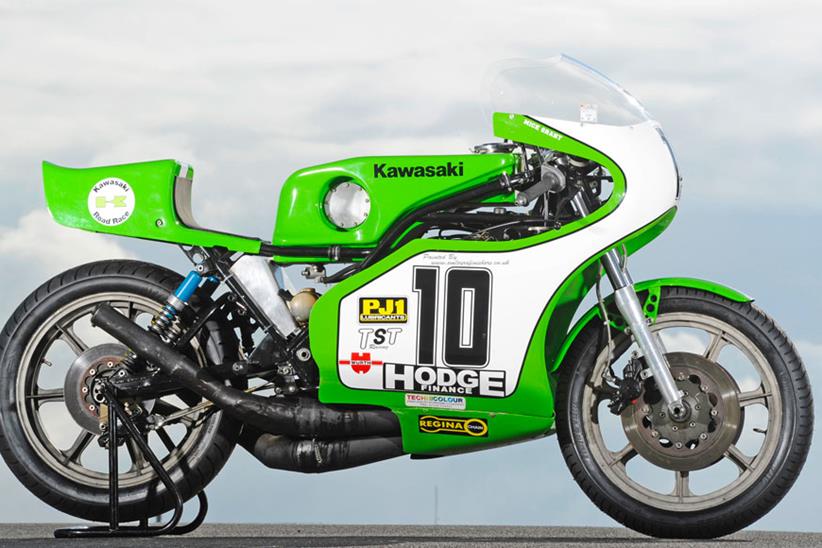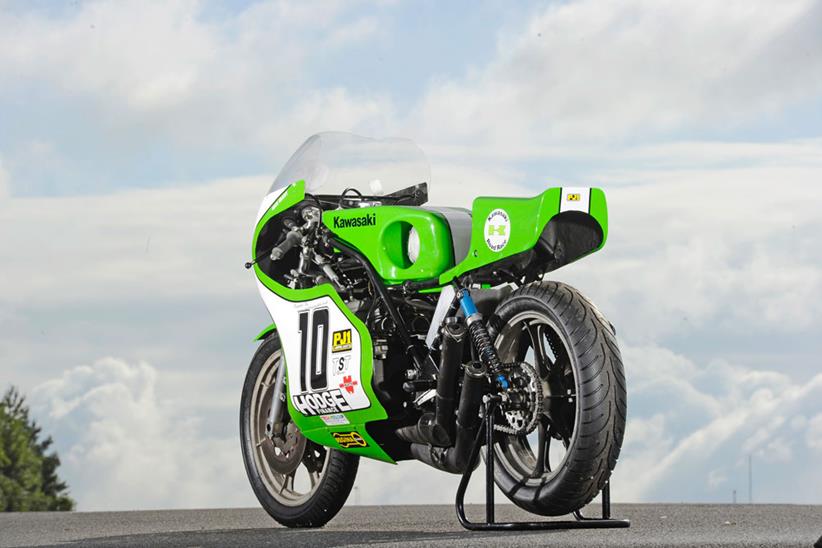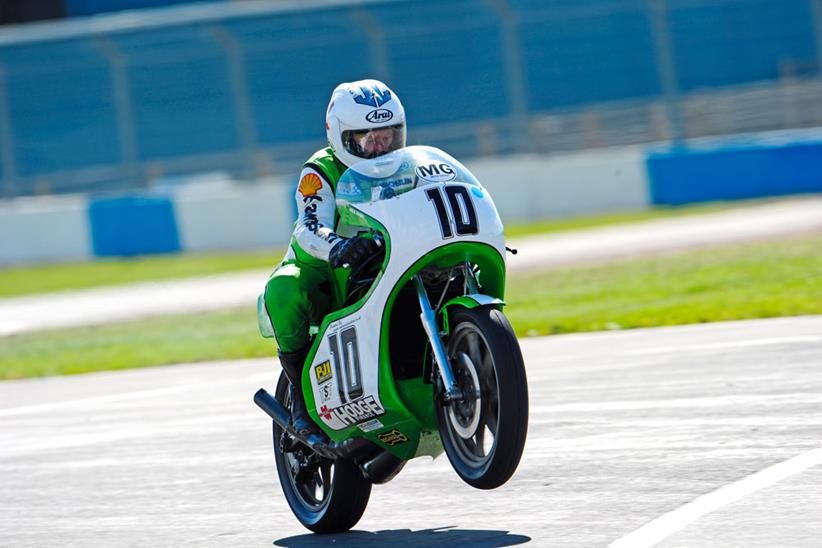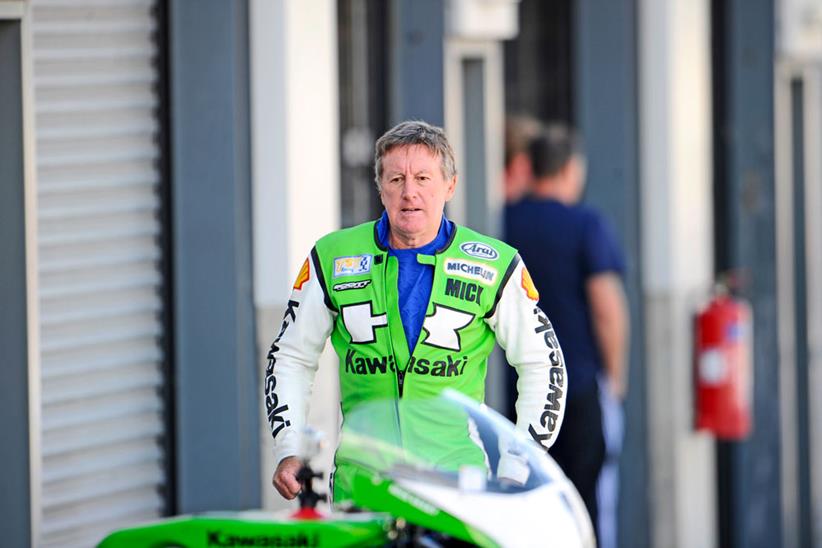Mick Grant's KR750: One careful owner
Mick Grant has cherished his KR750 since he raced it in the 1970s
![]() e live in an age of hyperbole, when even a slightly larger-than-average burger can be described as ‘amazing’. Guy Martin summed up this nonsense as well as anyone: “When a man eats his own head, I will hold me hands up and say: ‘THAT is unbelievable’.”
e live in an age of hyperbole, when even a slightly larger-than-average burger can be described as ‘amazing’. Guy Martin summed up this nonsense as well as anyone: “When a man eats his own head, I will hold me hands up and say: ‘THAT is unbelievable’.”
But Mick Grant’s 112.77mph TT lap in 1977 on this bike IS amazing. And, to me, unbelievable. I’ve raced the TT. I know first hand how hard it is. I have the nightmares and dented bank balance to prove it. And this was 35 years ago, when the circuit wasn’t anything like as smooth as it is now. He was clocked (though some doubt the figure’s accuracy) at 191mph on the run from the Creg down to Brandish.![]() I’ve proudly worn Mick Grant replica leathers at the TT for the last two years, and regard the seven-times TT winner as one of the greatest British riders of his generation. Mick took me for a guided lap round Oliver’s Mount when I made my debut there four years ago, something I’ll never forget. He’s not just a gifted rider, he’s a thoroughly nice chap too.
I’ve proudly worn Mick Grant replica leathers at the TT for the last two years, and regard the seven-times TT winner as one of the greatest British riders of his generation. Mick took me for a guided lap round Oliver’s Mount when I made my debut there four years ago, something I’ll never forget. He’s not just a gifted rider, he’s a thoroughly nice chap too.
There’s no rock star treatment with Mick. He turns up at Donington on time in an unmarked van with £150,000 of Kawasaki racing history in the back. I’d argue it’s one of the best looking race bikes of that generation. The bodywork and sculpted rear end with its distinctive lip is so rock and roll, so 1970s. I bloody love it.
The in-line three-cylinder motor runs magnesium crankcases rather than the more normal aluminium. It was bending the rules slightly at the time, but it shows how ‘factory’ this bike was. Two hand-crafted pipes exit to the left, one to right. All three have perfectly lock-wired baffles.
I could stare at the KR for hours in complete silence. Every now and then a small drop of oil spills on the Donington paddock tarmac. I think she’s just letting me know she’s still alive.
Mick’s going to take the bike out first, to make sure the jetting and gearing is spot on, and scrub in the new Avon race rubber. He runs alongside with the energy of a teenager, jumps on sidesaddle, drops the clutch and the bike cackles into life.
It sounds crisp. As Mick cracks the throttle, darts of blue two-stroke fire out of the three pipes. It must have been amazing to watch him and riders such as Roger Marshall, Tony Rutter and Joey Dunlop bump starting 750 two-strokes six abreast at the North West in the 1970s. I so wish I’d been born earlier.
Unfortunately Mick’s back in three laps. “The jetting is out,” he says through a half-open Arai. He changes out of his leathers, perches a pair of spectacles on the end of his nose and, helped by his friend Steve Underwood, gets to work. The main jets need changing and the needles raising a fraction. Everything is second nature to Mick; he’s done it so many times. It’s a pleasure to watch. In less than 30 minutes they have the bike together and ready to go. Now it’s my turn.
Rolling down Donington’s historic pit lane on Mick Grant’s TT-winning KR750, clutch in, blipping the throttle, I can’t think of anywhere I’d rather be. Then I stamp on the back brake. Idiot – it’s a right foot race shift, remember. I tiptoe around Redgate like a new rider on his CBT. Crashing something this irreplaceable simply isn’t an option. ![]() Out of Redgate, second gear, and she starts to come on song. There’s a warp noise from the exhaust, the revs pick up quickly and the front goes light. Wow, the old girl still has it. I panic a little and throw a gear at it as a glorious sunlit Donington unfolds in front me. The track looks perfect, but I take it easy. I feel a little braver out of the Old Hairpin and again the front lifts when the power kicks in around 6500rpm. Short-shifting up Starkey’s using a reverse-pattern right foot is hard work mentally. I try hanging off, and moving forward and backward in the seat under braking and acceleration, but it’s clearly not going to work. The KR’s narrow saddle was never designed for a modern knee-down riding style.
Out of Redgate, second gear, and she starts to come on song. There’s a warp noise from the exhaust, the revs pick up quickly and the front goes light. Wow, the old girl still has it. I panic a little and throw a gear at it as a glorious sunlit Donington unfolds in front me. The track looks perfect, but I take it easy. I feel a little braver out of the Old Hairpin and again the front lifts when the power kicks in around 6500rpm. Short-shifting up Starkey’s using a reverse-pattern right foot is hard work mentally. I try hanging off, and moving forward and backward in the seat under braking and acceleration, but it’s clearly not going to work. The KR’s narrow saddle was never designed for a modern knee-down riding style.
The front lifts again slightly over the crest down the straight where the Dunlop Bridge used to be, but I don’t want to get carried away as I’ve no idea what the brakes are like. Not bad as it turns out, but worringly I can smell fuel and there’s be some kind of liquid on the inside of the screen. Better pull in.
Mick checks the bike over in the pits. We have some fuel sloshing forward under braking and escaping out of the fuel cap. A rag and two heavy elastic bands are pressed in to service, and I re-join the session just five minutes later feeling like a factory rider.
Now it’s time to start having a bit more fun. The KR feels elongated and low at the back, something like an old FZR1000 or GSX-R1100. You expect it to be lethargic and slow-steering but in fact with just 130kg it turns with a minimum of effort, which takes you by surprise. Suspension is pretty good but there’s not a lot of travel; you’re more trusting the tyres than the suspension. Obviously I’m nowhere near the bike’s limits, but even at my pedestrian pace the plus points bubble to the surface. ![]() The brakes don’t look inspiring, and on a 200kg modern bike they’d be shocking. But as I use them harder they turn out to be pretty good. There’s so little weight I initially find I’m braking too early for the new chicane, and have to accelerate towards the corner.
The brakes don’t look inspiring, and on a 200kg modern bike they’d be shocking. But as I use them harder they turn out to be pretty good. There’s so little weight I initially find I’m braking too early for the new chicane, and have to accelerate towards the corner.
You have to keep the motor in the power, and in the higher gears it isn’t too vicious. Dare I say the bark is worse than the bite? The KR pulls cleanly from around 6,000rpm, but it’s not the scary animal I thought it would be. Then again this is Donington with acres of run-off, not flat out through Kirk Michael. The exhaust note is intoxicating, and tapping the gears accelerating hard up from the Old Hairpin is just paradise.
It’s the same powering out of the new chicane, front wheel in the air. It feels really quick, enough perhaps to reel in a well-ridden 600 on a track day at some points in a lap. But the KR makes its speed differently from today’s bikes. I can’t slide it out of Coppice, for example; there’s not enough feel. And where a modern bike can get on the power leaned right over, on the KR you have to wait because you’re not sure how the power’s going to come in. Once you’re almost upright, then you can go. Down Craner it’s really nice – less effort, in fact, than a big 1000. ![]() After 20 thrilling minutes the flag comes out. I’m covered in fuel and my left ball’s on fire but I’ve loved every minute of it. Running with sweat, I cruise in to the pits to find the owner delighted that his priceless motorcycle is still in one piece.
After 20 thrilling minutes the flag comes out. I’m covered in fuel and my left ball’s on fire but I’ve loved every minute of it. Running with sweat, I cruise in to the pits to find the owner delighted that his priceless motorcycle is still in one piece.
The KR is 35 years old, but it’s got a lightness and rawness that modern technology has lost. As I cool off, I worry that every bike I ride from this moment onwards could be a disappointment.
But I still can’t understand how Mick rode this thing so fast around the Isle of Man back in 1977.
The KR according to Mick
![]() MCN Sport: It felt quick. What power did it make back in the day?
MCN Sport: It felt quick. What power did it make back in the day?
Mick Grant: It’s a shame she isn’t running perfect. We need to get the fuelling right – I think she will be about 10bhp down. The gearing was way out too.
When we ran it, in the day, we never had her on a dyno. The jargon we got from Kawasaki was the stock engine was 120bhp, then a second tune/spec at 125-130bhp. There was a third totally unridable spec and that was higher again.
Unrideable, you say?
I rode it at Mettet in Belgium against Christian Sarron on the Yamaha. By the time I got out of the corner he was long gone – there was just no drive. In fact I broke the crank at that meeting.
So this is the ’77 bike with a stage two?
I had two bikes in 1977 and ’78 which were nearly identical. The ’77 bike did 191mph at the TT and lapped at 112.77mph. The 1978 bike, this one, won the ’78 Classic TT and set the lap record at 114.33mph. I’ve only got this one now.
And before that they were air-cooled?
Yes, higher revving and less reliable. We used to rev the air-cooled ones to 11,500 but break cranks all the time. In ’77, which is this bike, they dropped the rev limit to 9500 and they became more rideable and reliable, different altogether.
How did the 191mph top speed figure come about?
I told them where to put the speed trap, as you come down from the Creg towards Brandish. There was a 200m marker, and I could just get that on my shoulder before hitting the brakes. So we put the speed trap there. It was a true top speed 190.
![]() Some people question that…
Some people question that…
Yeah, I know, but we were hitting 180mph at Daytona on the banking in 1977. I think Kenny was doing 182 and you’re slower on the banking than you are in a straight line. And the bike is aerodynamic. I got hold of some Suzuki bodywork and fitted it for a practice but it just knocked back our peak rpm, wouldn’t pull in top. So I knew our bodywork worked.
I struggled to move around on the bike. Did you ever get your knee down?
I never did on the Kawasaki – never have done. A few riders moved the seat back a little. My arse never moved from the seat.
How did the KR compare with the Yamaha and Suzuki 750 two-strokes?
By 1978 we’d lost the plot. Barry and Yamaha had a better bike; they’d got the four-cylinders going good. Suzuki had the 680cc RG so we were a bit out of it by then. The KR was light and handled well but there was no development after the start of ’77, which was a shame.
Was it hard to ride at Oliver’s Mount?
No, it was gorgeous to ride around there, really gorgeous. Up to the café on the back straight it was so light, a lovely thing to ride, lifting from crest to crest, skimming over them like a motocross bike. My logic was, if the front wheel was in the air then you can’t have a handling issue can you? You used to have some massive wheelies there before they put that stupid little chicane in. They messed up a good track putting that there.
What was Sulby like at the TT?
It was proper back then – you haven’t lived, lad! There’s a photo of me passing the pub down Sulby and the bike is near vertical. I wish I’d kept it, or got the guy’s details. It was flat in top past the pub but the bike was so light it would be lifting over the bumps. Amazing. That’s what it was like down there flat out. Cronk y Voddy was the same – so bumpy and hard to keep in a straight line.
![]() What was it like over the jumps?
What was it like over the jumps?
Take Rhencullen – you come over the top, make the right then get it upright before the big jump. It’s like all the jumps really: just be dead accurate, make sure you’re straight and it’s ok. In ’75 I tried two steering dampers. The front was fine but the back was all over the place, like an angry dog wagging its tail.
The handling was hard to get right. If I’d known then what I know now we would have sorted it but we were in the dark back then. It was the same for everyone – we didn’t know, we just got on with it. We’d maybe change the springs, move the forks up and down or play around with the gearing but that was about it. You’d only go faster because that lap you was feeling brave and decided to just hold on tighter.
What about fuelling?
We used to go to Jurby to sort out the jetting as it was at sea level. If you went really safe it felt sluggish up the Mountain Mile, but you had to be a little safe to finish. If it was wrong you’d seize at the end of Sulby, so if you had it singing at the end of Sulby you knew you had a good ’un.
How did the chains last six laps?
We always had problems with chain stretches. On the fuel stops Nigel used to have to adjust the chain. In ’77, when I won it, it was jumping the sprocket that bad I was short-shifting to get her home.
How long were the fuel stops?
It took about ten seconds, much quicker than today because we had the big cans on top. It was dangerous, because you were still on the track. Daytona was even quicker and scarier: about three seconds, engine still revving, still red hot, big five-inch aircraft nozzles to get the air out and the fuel in. It was really dangerous. I’d pull in, count one thousand, two thousand, three thousand then away again – completely stupid. Best thing they ever did was banning the quick fillers. It’s better and safer for everyone now.
Where else was the KR good?
It was good at Scarborough, and brilliant at Macau, although by the time ’78 came around it was underdeveloped. I went from winning Macau to the Kawasaki factory, and the racing department was just some blokes in a shed type thing, doing motocross, the lot. They were very clever, don’t get me wrong, but a team of maybe 30 staff still producing winning bikes. When I moved to Honda I went to what is HRC now and it was a huge place with 1000 staff. How could they compete with that?
Photos Gareth Harford
















